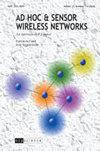STGT: SUMO-Based Traffic Mobility Generation Tool for Evaluation of Vehicular Networks
IF 0.6
4区 计算机科学
Q4 COMPUTER SCIENCE, INFORMATION SYSTEMS
引用次数: 3
Abstract
An approach to evaluate vehicular networks is to make use of simulators. A simulation engine allows the vehicular network to control the traffic simulation on run time. In this regard, researchers can assess their vehicular network models under realistic scenarios (e.g., highway, urban, rural). However, setting up these traffic mobility scenarios may result in a time-consuming task requiring the definition of several elements: (i) the road map, (ii) the traffic elements (e.g., traffic lights), (iii) the type of vehicles, and (iv) vehicle traces/routes. This paper focuses on facilitating this process, taking advantage of a well-known open-source traffic simulator called SUMO (Simulation of Urban MObility). Even though the SUMO simulator builds in several facilities to generate traffic mobility scenarios, it requires a considerable learning time. This paper proposes an open-source traffic simulator SUMO extension that encapsulates most SUMO facilities in an easy-to-use traffic generation tool called SUMO-based Traffic Mobility Generation Tool (STGT). The STGT tool facilities the scenario generation avoiding the learning curve of the SUMO framework, and provides performance statistics of the generated vehicular movements. The STGT tool copes with the whole traffic simulation process, including a graphical user interface for novice users and a command-line interface for advanced users.基于sumo的车辆网络交通移动性生成工具
一种评估车辆网络的方法是利用模拟器。仿真引擎允许车辆网络在运行时控制交通仿真。在这方面,研究人员可以在现实场景(如高速公路、城市、农村)下评估他们的车辆网络模型。然而,建立这些交通流动场景可能会导致一项耗时的任务,需要定义以下几个要素:(i)路线图,(ii)交通要素(例如交通灯),(iii)车辆类型,以及(iv)车辆轨迹/路线。本文的重点是促进这一过程,利用一个著名的开源交通模拟器称为SUMO(模拟城市交通)。尽管SUMO模拟器构建了几个设施来生成交通移动场景,但它需要相当长的学习时间。本文提出了一个开源的交通模拟器SUMO扩展,它将大多数SUMO设施封装在一个易于使用的交通生成工具中,称为基于SUMO的交通移动性生成工具(STGT)。STGT工具为场景生成提供了便利,避免了SUMO框架的学习曲线,并提供了生成的车辆运动的性能统计。STGT工具处理整个交通模拟过程,包括面向新手用户的图形用户界面和面向高级用户的命令行界面。
本文章由计算机程序翻译,如有差异,请以英文原文为准。
求助全文
约1分钟内获得全文
求助全文
来源期刊

Ad Hoc & Sensor Wireless Networks
工程技术-电信学
CiteScore
2.00
自引率
44.40%
发文量
0
审稿时长
8 months
期刊介绍:
Ad Hoc & Sensor Wireless Networks seeks to provide an opportunity for researchers from computer science, engineering and mathematical backgrounds to disseminate and exchange knowledge in the rapidly emerging field of ad hoc and sensor wireless networks. It will comprehensively cover physical, data-link, network and transport layers, as well as application, security, simulation and power management issues in sensor, local area, satellite, vehicular, personal, and mobile ad hoc networks.
 求助内容:
求助内容: 应助结果提醒方式:
应助结果提醒方式:


